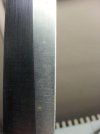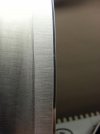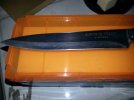I have sharpened my knives for years using stones, ceramic rods, a Lansky guided system, and a few other devices but I've never done it regularly or well. Recently, I decided to get serious about sharpening and, over the past 2 months or so have acquired 3 new systems:
- A Washboard from HeavyHanded
- A Ken Onion Edition Work Sharp
- A set of Shapton glass stones in 500, 1k, and 4k
I want to learn to freehand (hopefully well) with both the Shaptons and Washboard but I couldn't resist the Work Sharp I have a few pretty beat up folders but most of them are semi-serrated and aren't ideal to use as learning tools. So, I've been looking for several weeks for some more appropriate knives to practice with. Today, I hit the mother-lode. I found 2 partial sets of knives with matching wood blocks for $9.99 each at a Salvation Army store. The edges range from dull to completely blunt; most have stains or other marks; and some are damaged with chips, broken tips, and the like. One is a "Hampton Forge" set, the other is "Chicago Cutlery". Both are made of an unspecified Chinese stainless steel and are the type of inexpensive set sold at Walmart and Target. In other words, they are
I have a few pretty beat up folders but most of them are semi-serrated and aren't ideal to use as learning tools. So, I've been looking for several weeks for some more appropriate knives to practice with. Today, I hit the mother-lode. I found 2 partial sets of knives with matching wood blocks for $9.99 each at a Salvation Army store. The edges range from dull to completely blunt; most have stains or other marks; and some are damaged with chips, broken tips, and the like. One is a "Hampton Forge" set, the other is "Chicago Cutlery". Both are made of an unspecified Chinese stainless steel and are the type of inexpensive set sold at Walmart and Target. In other words, they are
PERFECT!
I'll be practicing with all 3 systems but will focus on the Shaptons, at least initially.
I intend to beat the hell out of these knives as I gain skill and refine my technique. I plan to sharpen them and then purposefully dull them so they can be sharpened again. And again. And again.
As I was driving around doing other errands this afternoon, it occurred to me that I was really excited because I had just bought a whole bunch of low quality knives in poor shape. Ohhhh, the irony...
- Tim
I'll post some pictures of my results as I progress. Here are some shots of the victims:
The knives and blocks:

After washing:

Condition example #1:

Condition example #2:

- A Washboard from HeavyHanded
- A Ken Onion Edition Work Sharp
- A set of Shapton glass stones in 500, 1k, and 4k
I want to learn to freehand (hopefully well) with both the Shaptons and Washboard but I couldn't resist the Work Sharp
PERFECT!
I'll be practicing with all 3 systems but will focus on the Shaptons, at least initially.
I intend to beat the hell out of these knives as I gain skill and refine my technique. I plan to sharpen them and then purposefully dull them so they can be sharpened again. And again. And again.
As I was driving around doing other errands this afternoon, it occurred to me that I was really excited because I had just bought a whole bunch of low quality knives in poor shape. Ohhhh, the irony...
- Tim
I'll post some pictures of my results as I progress. Here are some shots of the victims:
The knives and blocks:

After washing:

Condition example #1:

Condition example #2:







